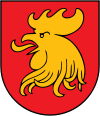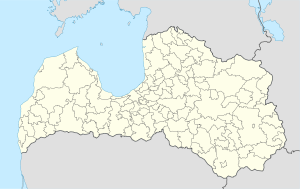- Madona
-
Not to be confused with Madonna.
Madona — Town — 
Flag
Coat of armsLocation in Latvia Coordinates: 56°51′N 26°13′E / 56.85°N 26.217°ECoordinates: 56°51′N 26°13′E / 56.85°N 26.217°E Country  Latvia
LatviaDistrict Madona municipality Town rights 1926 Government – Mayor Andrejs Ceļapīters Area – Total 10.5 km2 (4.1 sq mi) Population – Total 9,394 – Density 895/km2 (2,318/sq mi) Time zone EET (UTC+2) – Summer (DST) EEST (UTC+3) Postal code LV-4801 Calling code +371 648 Number of city council members 11 Madona (
 pronunciation (help·info); German: Modohn) is a town with town rights in the Vidzeme region of Latvia and is the center of the Madona municipality.
pronunciation (help·info); German: Modohn) is a town with town rights in the Vidzeme region of Latvia and is the center of the Madona municipality.Contents
History
The surrounding area of Madona had been populated in earlier times, which is confirmed by discoveries of old burial grounds in the city's vicinity. Madona is first mentioned in writing in 1461, when Archbishop Sylvester began renting the lands of Birži Manor. However, the Swedish government placed the land under state control. After the Great Northern War, Madona became property of the Russian Empire. Empress Elizabeth presented Birži Manor along with other of Vidzeme's manors to Count Alexander Buturlin.
Empress Catherine II bought the lands back as a present to another relative of her court — the Serbian major-general Maxim Zorić. From the 19th to the beginning of the 20th century, the location of Madona was the fields of Birži Manor.
According to one version, the name of Madona stems from the adjacent Madona Lake. According to another version, Madona got its name from Birži Manor, which German exonym is Madohn or Modohn. For this reason, the railway station situated at the Pļaviņas - Valka narrow gauge railway line was named Madona as well. The populated place that slowly emerged around the station also got this name after the erection of the Madona railway station in 1903.[1]
Village privileges was given to Madona 1 July 1921, and town privileges 7 June 1926. Since 1 April 1925 Madona was the center of the newly founded Madona parish. Madona had 1,357 inhabitants at the time.
Population
The Latvian Central Statistics Department reported 9,242 citizens as of 1 January 2007, with 888 people per square kilometre (0.37 square miles).[citation needed]
When it comes to age distribution of the Madona inhabitants, the majority group consisting of 5,925 people are registered as "labour-capable" (Latvian: darbaspējīgie); 1,339 are under the age of "labour-capability" and 1867 are over. As of 21 December 2007, there are 211 (3.5%) unemployed citizens of the labour force.[2]
Geography
The town of Madona lies in hilly surroundings, that descents underneath the town in a northwestern-southeastern direction. Several minor rivers and streams flows through the town, such as: Lisa River, Leivārīte, Ridzīte, Mucenieki River, Rieba River and Madona River — which flows can be seen in beautiful glens, like: The Love Glen, The Wedding Glen and The Divorce Glen. In The Love Glen is a park, in which the manmade water reservoir has one of the highest fountains in Latvia.
Notable locations and objects
- Madona City Museum — founded in 1944, the museum owns more than 107,000 historical items, it is located in historical Birži Manor.
- The Love Glen (Latvian: Mīlestības grava). Through The Love Glen flows the Madona River, along which shores slings park footpaths. At the entrance a pond with a fountain can be found.
- Madona Second High School — first three storey building in Madona, built 1924–26.
- Former hotel building — among the oldest buildings in town, built 1901 of boulders and bricks.
- Lazdona Lutheran Church — built 1802–05, inaugurated 1806.
- Lazdona Holy Trinity Orthodox Church — built 1863–66.
- Madona Catholic Church — built 1931–34.
References
External links
Cities, Municipalities and Parishes of the defunct Madona District Cities: Municipalities: Ērgļi • LubānaParishes: Arona • Barkava • Bērzaune • Dzelzava • Kalsnava • Lazdona • Ļaudona • Liezēre • Mārciena • Mētriena • Murmastiene • Ošupe • Prauliena • Sarkaņi • Varakļāni • VestienaTowns with town rights in Latvia Ainaži · Aizkraukle · Aizpute · Aknīste · Aloja · Alūksne · Ape · Auce · Baldone · Baloži · Balvi · Bauska · Brocēni · Cēsis · Cesvaine · Dagda · Dobele · Durbe · Grobiņa · Gulbene · Ikšķile · Ilūkste · Jaunjelgava · Jēkabpils · Kandava · Kārsava · Krāslava · Kuldīga · Ķegums · Lielvārde · Līgatne · Limbaži · Līvāni · Lubāna · Ludza · Madona · Mazsalaca · Ogre · Olaine · Pāvilosta · Piltene · Pļaviņas · Preiļi · Priekule · Rūjiena · Sabile · Salacgrīva · Salaspils · Saldus · Saulkrasti · Seda · Sigulda · Skrunda · Smiltene · Staicele · Stende · Strenči · Subate · Talsi · Tukums · Valdemārpils · Valka · Valmiera · Vangaži · Varakļāni · Viesīte · Viļaka · Viļāni · ZilupeCategories:- Madona
- Towns in Latvia
- 1926 establishments
Wikimedia Foundation. 2010.

